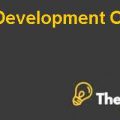
IRR OF THE PROJECT:
The calculation of the IRR is shown in the given exhibit. The IRR is basically a return point on which the yield of the company from that specific project becomes zero or equals to zero, in other words the NPV of the project will become zero. The higher IRR shows greater results in terms of risk.
In this case, Gencor and Alusaf group is considering for expanding the company in terms of growth via investment in a specific project that yields greater returns, but with the minimum amount of risk.
Before the calculation of the IRR, the first step is to calculate the cash flows from equity. The reason behind the choice equity cash flows will be discussed later. The data for this calculation has been taken from the case exhibit no. 6. The calculation includes the net operating profit calculation which is calculated by taking cash flow from interest after tax, adding a tax shield from interests, subtracting debt repayments.
The amount of equity cash flows is used to calculate IRR which is equal to 8%. If the IRR is greater than the expected rate of return, the project is worthwhile.
EXPECTED RATE OF RETURN:
The expected rate of return is the cost of capital, which is demanded by the shareholder in order to invest a sum of money. Moral requires significant investment of up to $1.4 billion, which is quite huge as it is almost equal to the GDP of Mozambique which is $1.7 billion.
This huge investment requires a greater investment return. The investment will be financed with a mix of debt and equity in equal proportion as proposed by the company to keep the level of risk balance.
As the amount of investment is too less it will also have an impact upon the risk profile of the company. In the given requirements, the asset beta is given, which is equal to 0.78. The asset beta is the measure of the risk of the company from the market perspective, but without any incorporation of debt capital.
The proposed expansion plan will be financed with the mix of debt and equity;therefore, the asset beta must need to be changed to equity beta in order to show the debt impact upon the overall risk profile of the company. The equity beta is calculated and shown in the given Exhibit which is equal to 1.326.
The beta less than 0 determines the situation of the risk in which the company is less risky from its overall market, while a beta of greater than 1 as in this case will be more risky than the overall market. Due to this higher equity beta, the investor will demand a higher return.
The tax rate is assumed to be 30%. The risk free rate is the US TIP rates given in the case requirement. The reason to use US TIP is that the requirement states that to calculate the real rate of return. The rate of return will be adjusted by the inflation impact.
Therefore, using US TIP will not require the cost of capital to be adjusted for inflation impact as it has already been adjusted.The market rate of return has been taken as an average rate, which is equal to 12% as given in the case (exhibit 11). The real rate of return is equal to 14.7%.
WHETHER TO INVEST OR NOT:
From the above two calculations of the real rate of return and Internal rate of return, it can be concluded that the Moral project doesn’t seem to be worthwhile as the IRR is lower than the expected real rate of return. This determines that if the company will invest in this project then as per the above two calculations, it will increase risk.
The increase in risk will make the position of the vulnerable and company can bear huge loss, which further may lead to bankruptcy.............
This is just a sample partial case solution. Please place the order on the website to order your own originally done case solution.








